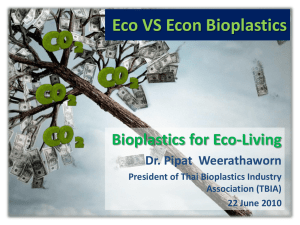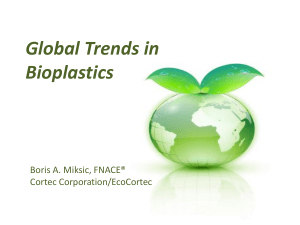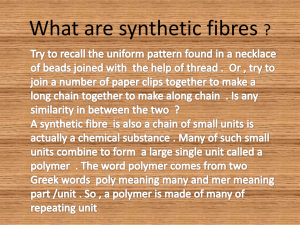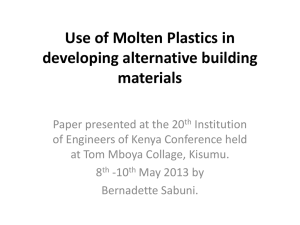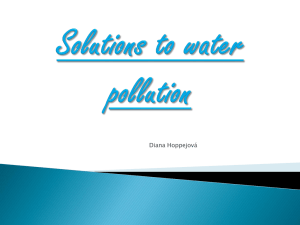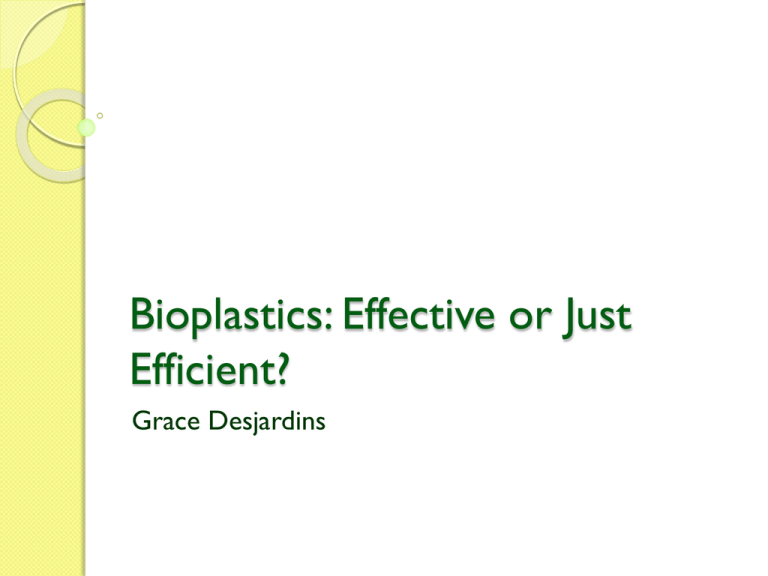
Bioplastics: Effective or Just
Efficient?
Grace Desjardins
Problem
How can bioplastics be easily made?
Can bioplastics function as well as oil-based plastics or
even plastics made partially from recycled materials?
Research
Plastics are polymers.
The production of bioplastics uses agro-polymers, such as starch.
◦ Break down the starch into a paste by adding heat and water
◦ The materials used affect the plasticizers.
Bacteria-based
Plant-based
Problems with Bioplastics:
◦ price of production
◦ health complications
◦ some don’t react well to heat
Benefits of Bioplastics:
◦ biodegradable
◦ eco-friendly production
less energy is used, thus less use of fossil fuels
◦ can use the same machinery as oil-based plastics
Hypothesis
If multiple aspects of oil-based plastics and bioplastics
are tested, then oil-based plastics will prove the most
applicable to everyday lifestyle.
Required Materials
Glycerin
Calculator
Corn starch
Medicine dropper
Vinegar
Computer
Water
Goggles
Soap-making Molds
Spatula
Aluminum foil
Lab apron
Cooking spoon
Pole
Hot Plate
Basket with attachment
Vernier Dual-Range Force Sensor
Clamp
Weights (in this case, batteries)
Bioplastic bag
Scale
oil-based plastic bag
100 mL beaker
400 mL beaker
Plastic bag made partially from recycled
materials
10 mL graduated cylinder
Tape
Procedure (Phase 1)
Place a plastic cup on a balance and zero it. Add cornstarch to the plastic cup
until reaching 10.00 g. Add this to the 400 mL beaker.
Measure 60 mL of distilled water out in a 100 mL beaker. Add this to the 400 mL
beaker.
Measure 5 mL of glycerin and 5 mL of vinegar using a 10 mL graduated cylinder
and add to the 400 mL beaker.
The 400 mL beaker and its contents were placed on a hot plate and stirred with
a stirring rod.
Once the substance becomes clear, thick, and slightly bubbling, pour it into the
molds.
Leave the bioplastic to dry for approximately 24 hours before removal from the
molds. Upon removal, place the samples on aluminum foil.
Procedure (Phase 2)
Cut samples from plastic bags (one oil-based, one bioplastic, and one made
partially from recycled materials) in dog bone shapes and draw two lines in
marker a distance of 5 cm apart on each sample. Five samples were used from
each bag.
Set up the Vernier Dual-Range Force Sensor using a pole and two supports of
the same height. To ensure its security, the pole was taped to the supports.
Connect the device to a computer, on which the Logger Lite 1.5 program had
previously been installed.
For each of the fifteen trials, add a clamp to the force sensor to hold the
plastic, which should be clipped after the system has been zeroed.
When the plastic sample is hanging from the force sensor, add a clamp to the
bottom of it. Attached to the clamp should be a chain which holds a basket,
which should have been weighed.
Measure objects of uniform mass and place them in the basket.
With every addition of mass, measure the distance between the marker lines
previously drawn on the plastic samples.
Record the force calculated on the Logger Lite 1.5 program. Continue until the
plastic sample can no longer hold the basket and its contents.
Variables
Control
Independent
◦ The plastic samples: bioplastic, oil-based plastic,
and plastic made partially from recycled materials
Dependent
◦ The tensile strength and tensile strain of the
plastics
Constants
◦
◦
◦
◦
◦
◦
Vernier Dual-Range Force Sensor
Basket and attachment
Batteries
Computer
Balance
Template for cutting samples
Data: Graph 1
Force (in Newtons) Applied to Plastics
2.5
2
Force (N)
1.5
Type A
Type B
Type C
1
0.5
0
Plastic Type
Data: Graph 2
Avg. Force Per Gram
40
35
Force (in Newtons)
30
25
Type A
20
Type B
Type C
15
10
5
0
Plastic Type
Data: Graph 3
Avg. Stretch of Plastic Types
0.3
0.25
Stretch of Plastic (in cm)
0.2
0.15
Type A
Type B
0.1
Type C
0.05
0
-0.05
Plastic Type
Data: Graph 4
Young's Modulus: Stress and Strain
4.5
4
3.5
Stress over Strain
3
2.5
Type A
Type B
2
Type C
1.5
1
0.5
0
Plastic Type
Data Summary
Average Tensile Strain:
◦ Oil-based plastics : 2.1460 N
◦
Bioplastics:1.4276 N
◦ Plastic made partially from recycled materials: 1.3396 N
Average Tensile Stretch:
◦ Oil-based plastic: 0.18 cm
◦ Bioplastic: 0.11 cm
◦ Plastic made partially from recycled materials: 0.04 cm
Average Force Per Gram
◦ Oil-based plastics: 29 N
◦ Bioplastic:23 N
◦ Plastic made partially from recycled materials: 23 N
T-tests
◦ Type A was significantly stronger than both Type B and Type C
There was no notable difference in strength between Type B and Type C.
◦ In terms of elasticity, Type A stretched more than Type C according to T-tests.
Type B was not remarkably different from Type A or Type C.
Conclusion
Hypothesis: “If multiple aspects of oil-based plastics and bioplastics
are tested, then oil-based plastics will prove the most applicable to
everyday lifestyle.”
The hypothesis was partially rejected because although the oil-based
plastic was the strongest, it did stretch more than the plastic that
contained recycled materials.
◦ In regards to strength, the oil-based plastic most likely has stronger bonds which
enable it to tolerate more force than the bioplastic and the plastic made partially
from recycled materials can.
◦ It is possible that the plasticizers in both the oil-based plastic and the bioplastic
enable both types to stretch the same amount. The plasticizers in plastic made
partially from recycled materials probably allow the plastic endure more in terms
of elasticity.
In regards to Phase One, it could have been unsuccessful for a
variety of reasons:
◦ Uneven spreading of ingredients
◦ Ingredients were not compatible
◦ Heating process
Conclusion (cont.)
What Could Have Gone Wrong
◦
◦
◦
◦
Accuracy of measurements
Transfer of ingredients
Changing numbers on the balance and Logger Lite 1.5 program
The way in which the Vernier Dual-Range force Sensor hung
Improvements
◦ Phase One could be continued until a successful bioplastic was
created.
◦ Phase Two could be continued by testing more samples of the three
plastics or adding additional types of plastics.
◦ More qualities of the plastics could be tested.
◦ Smaller increments of mass could be added to achieve more accurate
results.
Advancements
◦
◦
◦
◦
How can a better homemade bioplastic be created?
Might there be a way by which one can keep the samples uniform?
How quickly can the homemade bioplastic deteriorate?
if bioplastics were mass-produced, how would this affect the
economy?
References
4-H, Horton, R. L., PhD., Warkentien, C., & Gogolski, J. (n.d.). Agriculture at Work:
bioplastic. Retrieved September/October, 2011, from 4-H website: http://www.4h.org/agriscience/
Archana, T., & Preeti, C. (2011, November 17). Integration of natural and Biological
sources for the Production of Biopolymer: Actual and Potential Utilization of
various Wastes. Journal of Pharmacy Research, 4(1), 53-55. Retrieved from
http://jpronline.info/article/view/5579/2933
Averous, L., Pr. (2007, June). Bioplastics: Agro-polymers and Starch-based biomaterials
(Plasticized or Thermoplastic Starch-based materials). Retrieved October 10, 2011,
from http://www.biodeg.net/biomaterial.html
Bioplastics: Uses and Applications. (2009, October 28). Energy Business Daily.
Retrieved from http://energybusinessdaily.com/renewables/bioplastics-uses-andapplications/
Bortner, L., Dr. (2011, February 15). Young's Modulus. Retrieved November 14,
2011, from
http://www.physics.uc.edu/~bortner/labs/Physics%201%20experiments/Youngs%20
Modulus/Youngs%20Modulus%20htm.htm
Bourg, V., Berthe,V., & Chivrac, F. (2011, August 4). Overview of the use of
bioplastics in packaging [Web log post]. Retrieved from Bioplstic innovation:
http://bioplastic-innovation.com/2011/08/04/bioplastics-in-packaging/
References (cont.)
Dictionary.com Unabridged. (2012). Retrieved January, 2012, from Dictionary.com,
LLC website: http://dictionary.reference.com/
Freudenrich, C., Ph.D. (1998-2011). Making Plastics. Retrieved October 10, 2011,
from HowStuffWorks, Inc website: http://science.howstuffworks.com/plastic5.htm
Statistics in Biology. (n.d.). Retrieved February 15, 2012, from
http://www.usciences.edu/biology/bs130/statistics%20for%20biologyt%20test.html
Theinsathid, P., Chandrachai, A., & Keeratipibul, S. (2009). Managing Bioplastics
Business Innovation in Start Up Phase. Journal of Technology Management & Innovation,
4(1), 84, 86-88. Retrieved from
http://www.jotmi.org/index.php/GT/article/view/art106/476
Vernier. (2007, March 24). Dual-Range Force Sensor [Pamphlet]. Retrieved from
http://www.vernier-iberica.com/descargas/datos%20tecnicos/dfs-bta.pdf
What Is Polymer Resin? (2003-2011). Retrieved October 15, 2011, from wiseGEEK
website: http://www.wisegeek.com/what-is-polymer-resin.htm
Wilbraham, A. C., Staley, D. D., Matta, M. S., & Waterman, E. L. (2008). 23.4
Polymerization. In Chemistry (pp. 747-752). Boston, Massachusetts: Pearson Prentice
Hall.
Woodford, C. (2011, October 3). Bioplastics and biodegradable plastics: Explain that
Stuff! Retrieved from http://www.explainthatstuff.com/bioplastics.html


